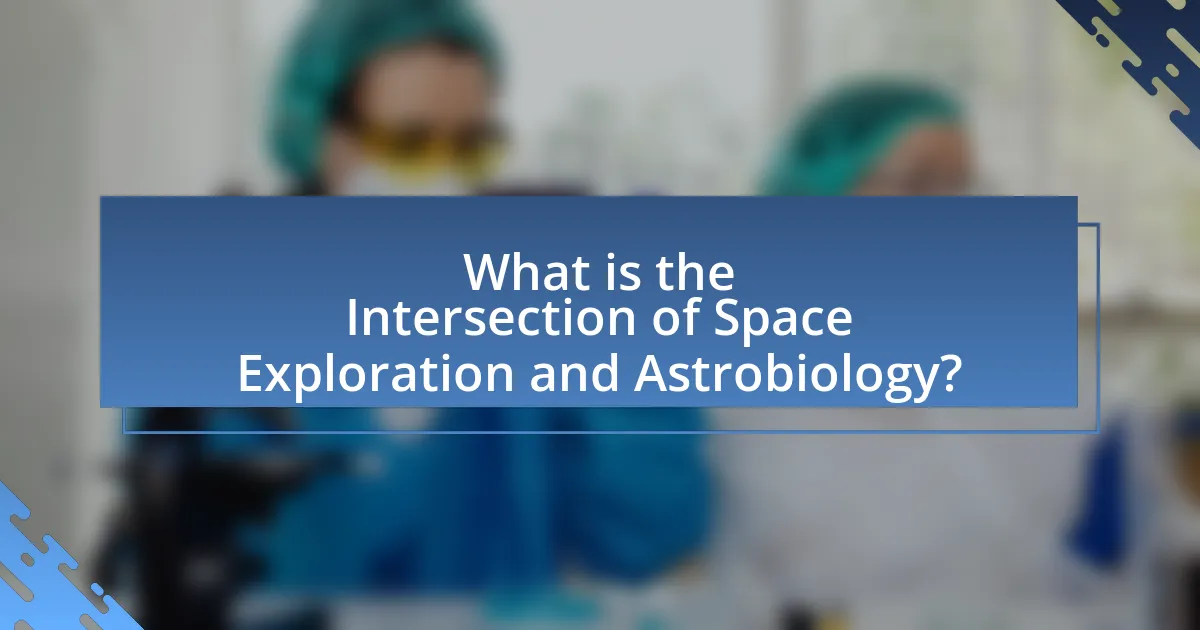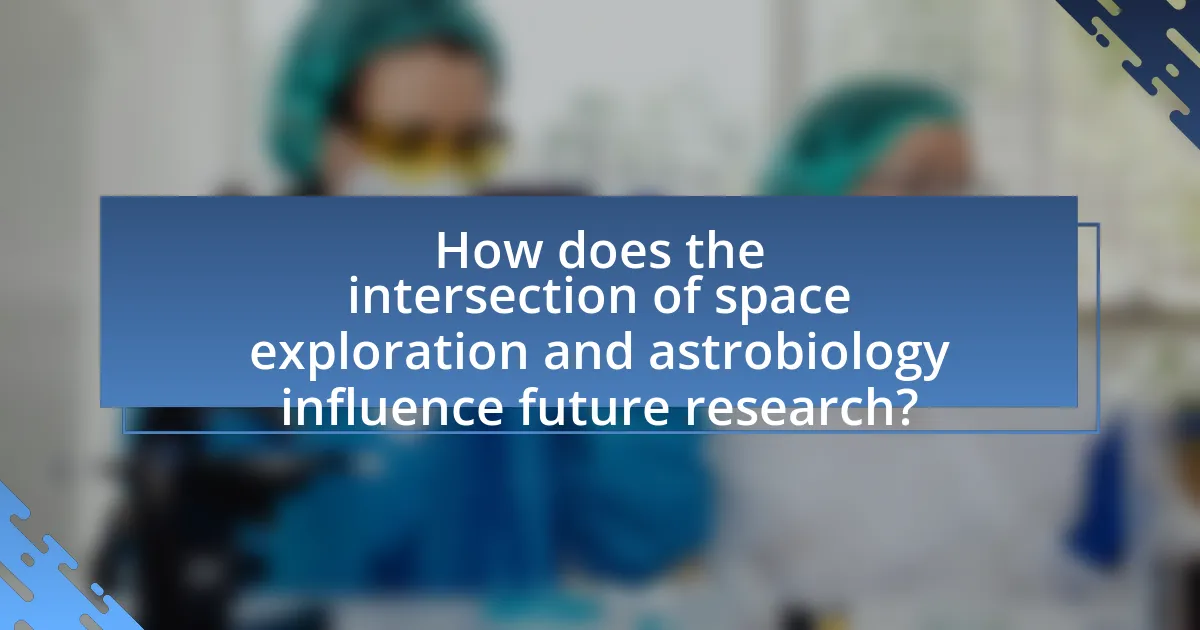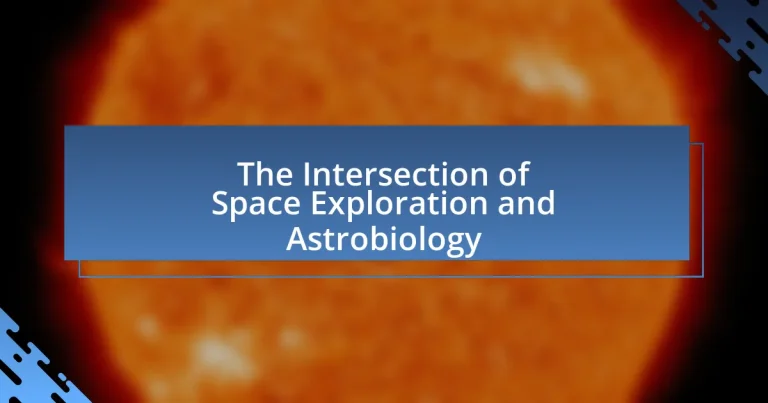The article examines the intersection of space exploration and astrobiology, focusing on the study of potential extraterrestrial life and the conditions necessary for its existence. It highlights the relationship between space missions, such as those by NASA and ESA, and astrobiological research, emphasizing key objectives like the search for biosignatures and understanding life’s origins. The article also discusses current missions, technologies used, and the role of rovers and landers in astrobiological research, while addressing challenges, ethical considerations, and the importance of interdisciplinary collaboration in advancing the field.

What is the Intersection of Space Exploration and Astrobiology?
The intersection of space exploration and astrobiology involves the study of potential life beyond Earth and the conditions necessary for life in extraterrestrial environments. Space exploration missions, such as those conducted by NASA and ESA, aim to discover habitable conditions on other planets and moons, while astrobiology focuses on understanding the origins, evolution, and distribution of life in the universe. For instance, the Mars rovers have been equipped with instruments to analyze soil and atmospheric samples for signs of past microbial life, demonstrating the practical application of astrobiological principles in space exploration.
How do space exploration and astrobiology relate to each other?
Space exploration and astrobiology are interconnected fields that both aim to understand the potential for life beyond Earth. Space exploration involves missions to other planets and moons, which provide critical data about environments that may support life, such as Mars and the icy moons of Jupiter and Saturn. Astrobiology, on the other hand, studies the origins, evolution, and potential existence of life in the universe, using insights gained from space exploration to inform hypotheses about where and how life might arise. For example, the discovery of extremophiles on Earth has influenced the search for similar life forms in extreme environments on other celestial bodies, demonstrating the direct relationship between the two disciplines.
What are the key objectives of space exploration in relation to astrobiology?
The key objectives of space exploration in relation to astrobiology include the search for extraterrestrial life, understanding the origins of life, and studying the potential for life in extreme environments. These objectives drive missions to planets and moons, such as Mars and Europa, where conditions may support life. For instance, the Mars 2020 mission aims to collect samples that could reveal past microbial life, while missions to Europa focus on analyzing its subsurface ocean for signs of habitability. These efforts are grounded in the scientific understanding that exploring diverse environments enhances our knowledge of life’s potential beyond Earth.
How does astrobiology inform the goals of space missions?
Astrobiology informs the goals of space missions by guiding the search for extraterrestrial life and understanding the conditions necessary for life to exist. This scientific discipline integrates knowledge from biology, chemistry, and planetary science to develop mission objectives that focus on identifying habitable environments, such as Mars and the icy moons of Jupiter and Saturn. For instance, missions like NASA’s Perseverance rover are designed to explore the Martian surface for signs of past life and collect samples for future return to Earth, directly reflecting astrobiological principles. Additionally, astrobiology influences the design of instruments and experiments on spacecraft, ensuring they are capable of detecting biosignatures and analyzing planetary atmospheres for potential habitability.
Why is the study of astrobiology important for space exploration?
The study of astrobiology is important for space exploration because it helps scientists understand the potential for life beyond Earth and the conditions necessary for life to exist. This understanding guides the search for extraterrestrial life by identifying habitable environments on other planets and moons, such as Mars and Europa. For instance, missions like the Mars Rover have been designed with astrobiological principles in mind, targeting locations where water and organic materials are present, which are essential for life as we know it. By integrating astrobiology into space exploration, researchers can develop more effective strategies for exploring other celestial bodies and increase the chances of discovering life beyond our planet.
What insights does astrobiology provide about potential extraterrestrial life?
Astrobiology provides critical insights into the potential for extraterrestrial life by studying the conditions necessary for life and identifying environments beyond Earth that may support it. Research in astrobiology has revealed that life can exist in extreme conditions, such as high radiation, extreme temperatures, and high salinity, as evidenced by extremophiles found on Earth. These findings suggest that similar life forms could thrive in environments like the subsurface oceans of Europa or the methane lakes on Titan. Additionally, astrobiology employs the study of exoplanets, utilizing data from missions like Kepler and TESS, which have identified numerous Earth-like planets in habitable zones around their stars, further supporting the possibility of life elsewhere in the universe.
How does understanding life on Earth enhance our search for life beyond?
Understanding life on Earth enhances our search for life beyond by providing a framework for identifying potential biosignatures and habitable environments elsewhere in the universe. The study of extremophiles, organisms that thrive in extreme conditions on Earth, informs scientists about the possible existence of life in similar harsh environments on other planets, such as Mars or the icy moons of Jupiter and Saturn. For instance, the discovery of microbial life in hydrothermal vents and acidic lakes demonstrates that life can exist in conditions previously thought to be inhospitable, expanding the criteria for habitability in extraterrestrial settings. This knowledge allows researchers to refine their search strategies and develop more targeted missions to explore celestial bodies that may harbor life.

What are the current missions that explore the intersection of space exploration and astrobiology?
Current missions exploring the intersection of space exploration and astrobiology include NASA’s Perseverance rover on Mars, which is searching for signs of ancient microbial life and collecting samples for future return to Earth. Additionally, the European Space Agency’s ExoMars mission aims to investigate the Martian environment and assess its habitability. The James Webb Space Telescope is also contributing by studying exoplanets’ atmospheres to identify potential biosignatures. These missions are designed to enhance our understanding of life’s potential beyond Earth, supported by their specific scientific objectives and methodologies.
Which space missions are specifically designed to search for extraterrestrial life?
The space missions specifically designed to search for extraterrestrial life include NASA’s Mars 2020 Perseverance rover, which is tasked with seeking signs of ancient microbial life on Mars and collecting samples for future return to Earth. Additionally, the European Space Agency’s ExoMars mission aims to search for biosignatures on the Martian surface. The Kepler Space Telescope, although not a direct search for life, has identified thousands of exoplanets in habitable zones, providing targets for future life-detection missions. Furthermore, the James Webb Space Telescope will analyze the atmospheres of exoplanets for potential biosignatures. These missions are grounded in astrobiological research, focusing on environments that could support life beyond Earth.
What technologies are being used in these missions?
Robotic spacecraft, advanced telescopes, and in-situ analysis instruments are the primary technologies used in space exploration missions related to astrobiology. Robotic spacecraft, such as Mars rovers, utilize autonomous navigation and sample collection systems to analyze soil and rock for signs of past life. Advanced telescopes, like the James Webb Space Telescope, employ infrared imaging to detect exoplanets and analyze their atmospheres for biosignatures. In-situ analysis instruments, including mass spectrometers and gas chromatographs, are deployed on planetary surfaces to conduct real-time chemical analyses, providing critical data on the potential for life. These technologies collectively enhance our understanding of the conditions necessary for life beyond Earth.
How do these missions collect and analyze data related to astrobiology?
Missions collect and analyze data related to astrobiology through a combination of remote sensing, in-situ measurements, and sample return techniques. For instance, spacecraft equipped with spectrometers analyze the chemical composition of planetary atmospheres and surfaces, identifying potential biosignatures such as methane or oxygen. Additionally, landers and rovers conduct experiments on planetary bodies, measuring soil and rock samples for organic compounds and microbial life indicators. The Mars 2020 Perseverance rover, for example, utilizes its suite of scientific instruments to search for signs of ancient life and collect samples for future return to Earth. These methodologies provide critical insights into the conditions that may support life beyond Earth, reinforcing the scientific understanding of astrobiology.
What role do rovers and landers play in astrobiological research?
Rovers and landers are essential tools in astrobiological research as they enable in-situ exploration and analysis of extraterrestrial environments. These robotic platforms are equipped with scientific instruments that can conduct experiments, analyze soil and rock samples, and search for signs of past or present life. For instance, NASA’s Curiosity rover has been instrumental in discovering organic molecules on Mars, providing evidence that the planet once had conditions suitable for life. Additionally, the Perseverance rover is actively collecting samples that may contain biosignatures, further advancing our understanding of astrobiology. Thus, rovers and landers play a critical role in gathering data that informs our search for life beyond Earth.
How do rovers contribute to our understanding of Martian life potential?
Rovers contribute to our understanding of Martian life potential by conducting in-situ analysis of the Martian surface and atmosphere, which helps identify conditions that may support life. For example, NASA’s Perseverance rover is equipped with advanced scientific instruments that analyze soil samples for organic compounds and detect signs of past microbial life. The rover’s findings, such as the discovery of ancient river deltas and the presence of clay minerals, provide crucial evidence about the planet’s habitability in its geological history. These analyses are essential for assessing whether Mars ever had the necessary conditions for life, thereby enhancing our understanding of astrobiology and the potential for life beyond Earth.
What findings have landers provided regarding the habitability of other celestial bodies?
Landers have provided significant findings regarding the habitability of other celestial bodies, particularly through the analysis of surface conditions and the presence of essential elements for life. For example, NASA’s Mars Curiosity rover has detected organic molecules and seasonal methane fluctuations, suggesting potential biological activity in the past. Additionally, the Phoenix lander confirmed the presence of water ice on Mars, indicating that liquid water may have existed, which is crucial for habitability. On Europa, data from the Galileo spacecraft suggests a subsurface ocean beneath its icy crust, raising the possibility of an environment that could support life. These findings collectively enhance our understanding of where life might exist beyond Earth.

How does the intersection of space exploration and astrobiology influence future research?
The intersection of space exploration and astrobiology significantly influences future research by driving the search for extraterrestrial life and enhancing our understanding of life’s potential in diverse environments. This synergy leads to the development of advanced technologies and methodologies, such as the Mars rover missions, which utilize astrobiological principles to identify signs of past or present life on other planets. For instance, NASA’s Perseverance rover, launched in 2020, employs astrobiological techniques to analyze Martian soil and atmosphere, providing critical data that informs both planetary science and the search for life beyond Earth. This collaborative approach not only expands our knowledge of life’s adaptability but also informs the design of future missions aimed at exploring potentially habitable exoplanets, thereby shaping the trajectory of scientific inquiry in both fields.
What are the emerging trends in astrobiological research driven by space exploration?
Emerging trends in astrobiological research driven by space exploration include the search for biosignatures on exoplanets, the study of extremophiles on Earth to understand potential life in harsh environments, and the development of advanced robotic missions for sample return from celestial bodies. These trends are supported by missions like NASA’s Perseverance rover, which is actively collecting samples on Mars to analyze for signs of past life, and the James Webb Space Telescope, which is capable of characterizing the atmospheres of distant exoplanets for chemical indicators of life. Additionally, research into the potential for life in subsurface oceans of moons like Europa and Enceladus is gaining momentum, as evidenced by upcoming missions such as NASA’s Europa Clipper.
How are advancements in technology shaping the future of astrobiology?
Advancements in technology are significantly shaping the future of astrobiology by enhancing our ability to detect and analyze extraterrestrial life. Innovations such as advanced telescopes, like the James Webb Space Telescope, allow scientists to observe distant exoplanets and analyze their atmospheres for biosignatures, which are indicators of life. Additionally, robotic missions, such as NASA’s Perseverance rover on Mars, utilize sophisticated instruments to search for signs of past microbial life and collect samples for future return to Earth. These technological developments not only improve our understanding of potential habitats beyond Earth but also refine our methods for identifying life forms, thereby expanding the scope of astrobiological research.
What collaborative efforts are being made between space agencies and astrobiologists?
Space agencies and astrobiologists are collaborating on missions to explore extraterrestrial environments that may harbor life. For instance, NASA’s Mars missions, including the Perseverance rover, are designed with input from astrobiologists to search for signs of past microbial life and collect samples for future return to Earth. Additionally, the European Space Agency’s (ESA) ExoMars program aims to investigate the Martian surface and subsurface for biosignatures, directly involving astrobiologists in mission planning and execution. These collaborations leverage the expertise of astrobiologists to enhance the scientific objectives of space missions, ensuring that the search for life beyond Earth is informed by the latest understanding of biology and environmental conditions.
What challenges do researchers face at this intersection?
Researchers at the intersection of space exploration and astrobiology face significant challenges, including the limitations of current technology for detecting extraterrestrial life and the vast distances involved in space travel. The technological constraints hinder the ability to conduct in-depth analyses of distant celestial bodies, which are essential for understanding potential biosignatures. For instance, missions like the Mars 2020 Perseverance rover aim to collect samples, but the return of these samples to Earth for comprehensive study is a complex and lengthy process. Additionally, the harsh environments of other planets pose challenges for both robotic and human exploration, as they require advanced life support systems and protective measures against radiation and extreme temperatures. These factors complicate the design and execution of missions aimed at exploring the potential for life beyond Earth.
How do funding and resource allocation impact astrobiological studies?
Funding and resource allocation significantly impact astrobiological studies by determining the scope, scale, and feasibility of research projects. Adequate funding enables the development of advanced technologies, such as space missions and telescopes, which are essential for exploring extraterrestrial environments. For instance, NASA’s budget for astrobiology research, which was approximately $60 million in 2021, directly influences the number of missions and experiments that can be conducted to search for life beyond Earth. Additionally, resource allocation affects collaboration opportunities among institutions, as well as the ability to attract top researchers in the field. The prioritization of astrobiology within funding agencies can lead to breakthroughs in understanding life’s potential in the universe, as seen with the Mars rover missions that have provided critical data on the planet’s habitability.
What ethical considerations arise in the search for extraterrestrial life?
The ethical considerations in the search for extraterrestrial life include the potential impact on discovered life forms, the implications of contamination, and the responsibilities of humanity in exploration. When scientists search for extraterrestrial life, they must consider the moral obligation to avoid harming any existing ecosystems, as highlighted by the Outer Space Treaty of 1967, which emphasizes the need for responsible exploration. Additionally, the risk of biological contamination, both from Earth to other celestial bodies and vice versa, raises concerns about the integrity of extraterrestrial environments and the potential for unintended consequences. These ethical dilemmas necessitate a framework for responsible exploration that prioritizes the preservation of both Earth and extraterrestrial ecosystems.
What practical steps can be taken to enhance the study of astrobiology through space exploration?
To enhance the study of astrobiology through space exploration, missions should prioritize the search for biosignatures on other planets and moons. This involves deploying advanced robotic spacecraft equipped with sophisticated instruments capable of detecting organic compounds and microbial life. For instance, the Mars 2020 Perseverance rover is designed to collect samples that may contain signs of ancient life, demonstrating a practical approach to astrobiological research. Additionally, missions to icy bodies like Europa and Enceladus should focus on subsurface ocean exploration, as these environments may harbor extraterrestrial life. The James Webb Space Telescope also plays a crucial role by analyzing exoplanet atmospheres for chemical signatures indicative of life. These steps collectively enhance our understanding of life’s potential beyond Earth.
How can interdisciplinary collaboration improve research outcomes?
Interdisciplinary collaboration can significantly improve research outcomes by integrating diverse expertise and perspectives, leading to innovative solutions and comprehensive understanding of complex problems. For instance, in the intersection of space exploration and astrobiology, collaboration between astrophysicists, biologists, and chemists enables the development of advanced life-detection technologies and enhances the interpretation of data from extraterrestrial environments. Research conducted by the National Aeronautics and Space Administration (NASA) has shown that interdisciplinary teams are more effective in addressing multifaceted challenges, as they can leverage varied methodologies and insights, ultimately resulting in more robust findings and breakthroughs in understanding life beyond Earth.
What best practices should be adopted for future missions focused on astrobiology?
Future missions focused on astrobiology should adopt a multidisciplinary approach that integrates biology, chemistry, geology, and planetary science. This approach ensures comprehensive data collection and analysis, enhancing the understanding of potential life forms and their environments. For instance, missions like the Mars 2020 Perseverance rover utilize advanced instruments to analyze soil and rock samples, demonstrating the effectiveness of combining various scientific disciplines. Additionally, implementing strict planetary protection protocols is essential to prevent contamination of extraterrestrial environments, as outlined by the Committee on Space Research (COSPAR). These practices not only safeguard the integrity of astrobiological research but also uphold ethical standards in space exploration.

